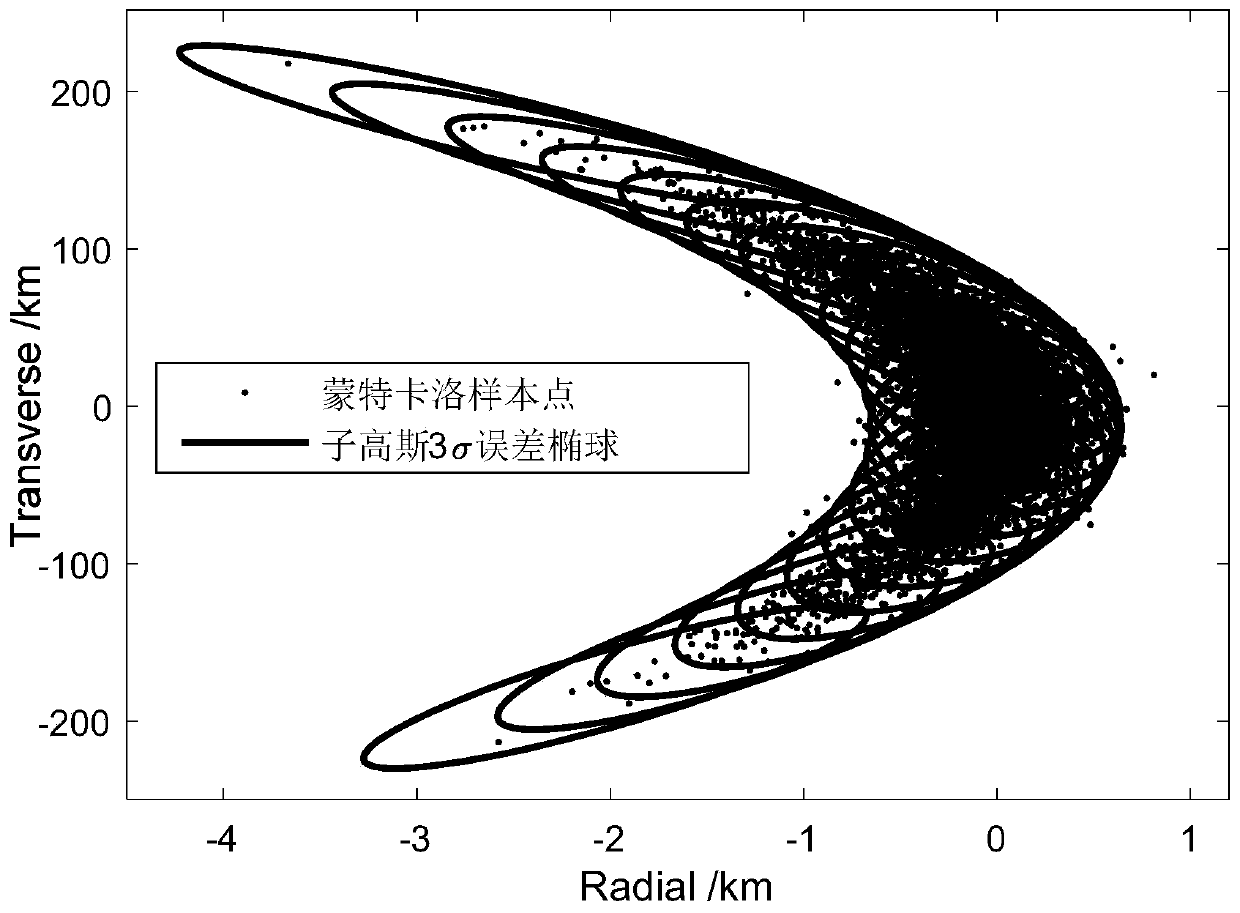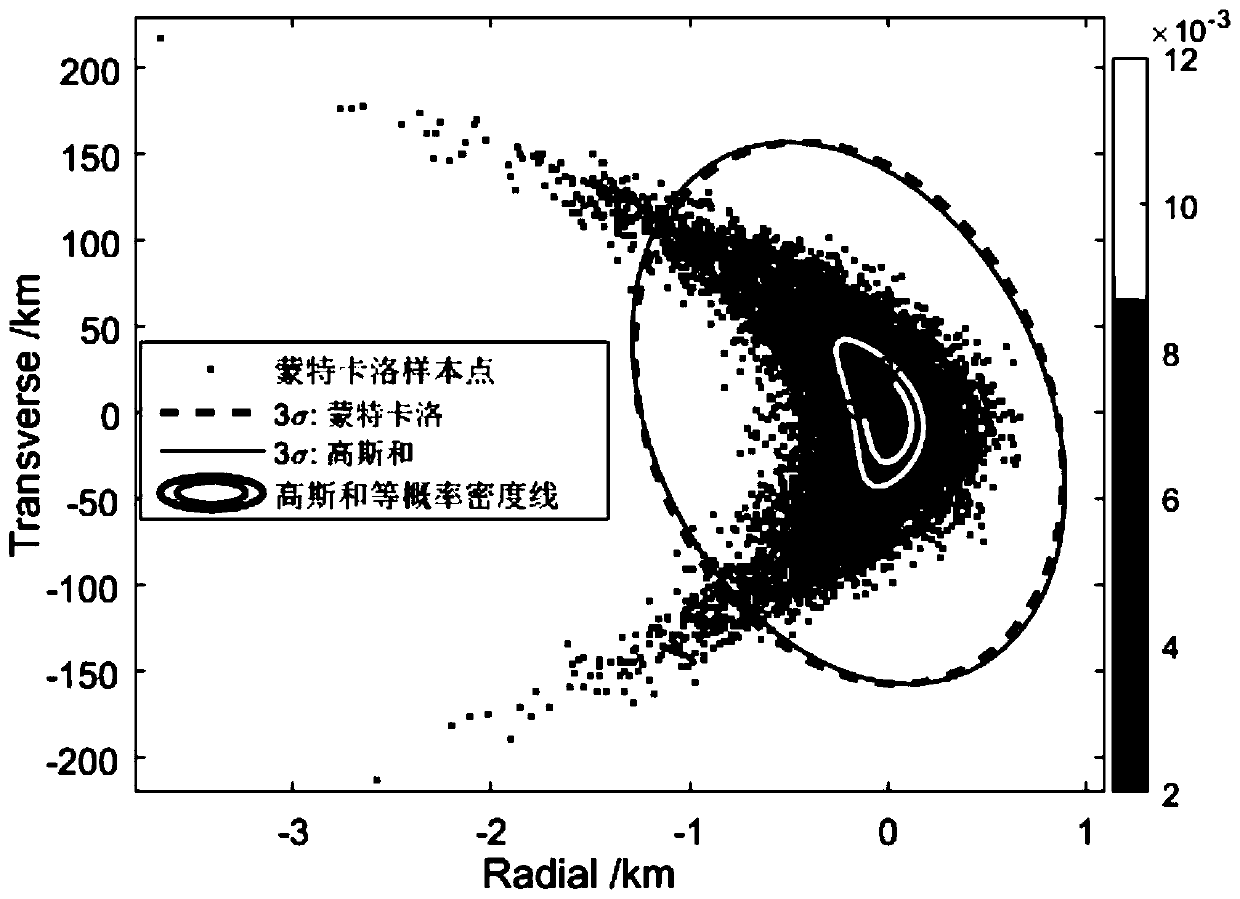An analytical method for analyzing satellite nonlinear relative motion bias propagation
A technology of relative motion and analysis method, applied in non-electric variable control, vehicle position/route/altitude control, instruments and other directions, which can solve problems such as large amount of calculation and unsuitable satellite formation flight missions.
- Summary
- Abstract
- Description
- Claims
- Application Information
AI Technical Summary
Problems solved by technology
Method used
Image
Examples
Embodiment 1
[0057] Such as figure 1 As shown, the implementation steps of the satellite nonlinear relative motion deviation propagation analysis method analyzed in this embodiment include:
[0058] 1) Designate the main satellite and the slave satellite for the two satellites flying in formation, and input the absolute orbital state of the reference satellite at the initial moment, the nominal relative motion state of the two satellites, and input the probability density function of the deviation of the initial relative motion state;
[0059] 2) Based on the absolute orbit state of the reference satellite at the initial moment and the nominal relative motion state of the two satellites, according to the consideration J 2 The perturbed nonlinear relative motion equation is used to calculate the first-order and second-order state transition tensors used to analyze and predict the relative motion state of the satellite;
[0060] 3) Based on the first-order and second-order state transition ...
Embodiment 2
[0101] This embodiment is basically the same as Embodiment 1, and the main difference is: in this embodiment, the initial and terminal deviations in step 3) are both Gaussian distributions, so the calculation of step 6) is no longer performed, and only step 5) is required The mean value and covariance matrix of the nonlinear relative state deviation are analytically predicted, and the probability density function of the terminal deviation can be determined by its mean value and covariance matrix. This embodiment only needs to predict the mean value and covariance matrix of the relative state deviation, and does not need to use the Gaussian sum model to predict the probability density function. The method analysis and calculation efficiency are high, and the implementation is simple; the calculation efficiency is high. see Figure 4 The comparison of the forecast results of the shown terminal error mean and covariance matrix shows that the Gaussian sum model used in the method ...
Embodiment 3
[0103] This embodiment is basically the same as Embodiment 1, and its main difference is: in this embodiment, the calculation of step 2) is no longer carried out, and the calculation of (6) formula in step 3) The matrix directly uses the formula (1) in step 1) Matrix replacement. Because the satellite's absolute state deviation can be used as a relative state, the formula (1) can be used for forecasting, so this embodiment can be used to analytically predict the mean value, covariance matrix and probability density function of the satellite's absolute state deviation. This embodiment considers the J2 perturbation term and the second-order nonlinear term, and can be used for long-term, high-precision absolute state deviation propagation of a single spacecraft, and the method analysis and calculation efficiency are high.
PUM
 Login to View More
Login to View More Abstract
Description
Claims
Application Information
 Login to View More
Login to View More - R&D
- Intellectual Property
- Life Sciences
- Materials
- Tech Scout
- Unparalleled Data Quality
- Higher Quality Content
- 60% Fewer Hallucinations
Browse by: Latest US Patents, China's latest patents, Technical Efficacy Thesaurus, Application Domain, Technology Topic, Popular Technical Reports.
© 2025 PatSnap. All rights reserved.Legal|Privacy policy|Modern Slavery Act Transparency Statement|Sitemap|About US| Contact US: help@patsnap.com



